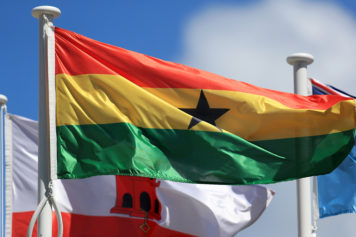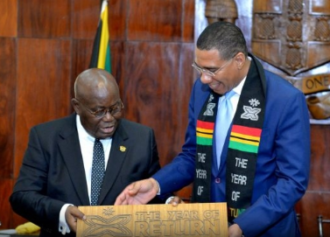The elders had poured libations, the holy men had delivered invocations, and all had sworn allegiance to the Ashanti kingdom. A battery of percussionists, glistening with sweat, started pounding out waves of rhythm that brought hundreds of guests, draped in elaborate kente cloth, to their feet.
A scrum of men formed at one end of the hall and hoisted to their shoulders a wooden litter. It bore the newly inaugurated chief, wearing gold jewelry and a gold-studded leather crown, who bobbed above the celebrants and flicked a horsetail whisk and a golden scarf in a studied regality.
And so, just before dawn the last Sunday in May, one of the most elaborate rituals in immigrant New York reached its apogee. The man at the center was Nana Acheampong-Tieku of the Bronx, New York regional chief of the Ashanti people from Ghana in West Africa.
The inauguration was part of a quadrennial, two-day ceremony in the Bronx that is a high point in the Ashanti diaspora’s calendar, serving to strengthen traditions and community ties in New York. “This is gorgeous, this makes me happy,” said Kojo Ampah Sahara, a community leader who helped organize the event. “This is who we are.”
Nominated by a 10-member council of regional Ashanti elders, and voted on by community members, the regional chief has a range of ceremonial and practical duties. He mediates familial and business disputes, including fractured marriages, before they reach the courts. He helps Ghanaian immigrants find employment, lodging, medical care and legal help.
He also leads a fund-raising effort for scholarships and for a children’s hospital in Ghana among New York’s growing Ghanaian population, the largest African immigrant group in the city, which numbers more than 22,000, up from about 14,900 in 2000, according to the Census Bureau.
Mr. Acheampong-Tieku’s most pressing challenge, however, is the survival of his very organization. He serves under the aegis of the Asanteman Association of U.S.A., an Ashanti cultural group formed in 1982. But even as the population of Ghanaians and their subgroups has grown in the New York region, the association’s membership has plummeted. It has about 70 dues-paying members, down from about 1,000 in the 1990s.
Many of the association’s original members, most of them immigrants, have moved back to Ghana or died, but they have not been replaced by their assimilated, American-born offspring or newly arrived Ghanaians. This is a pattern familiar to many immigrant diasporas: Organizations formed by early waves of immigrants struggle to remain relevant as the needs and desires of later generations and more recent newcomers shift.
Nana Kofi Appiah, 74, who helped create the organization, said none of his five children living in the United States were interested in taking part.
“They are more American than Ghanaian,” he said. “They think it’s an old person’s organization.”
Mr. Acheampong-Tieku, 52, has felt this tension in his own home. He has four children, but only one — Vera, 20 — has decided to participate in the association’s activities, and only after being lobbied by Mr. Ampah Sahara. At 34, Mr. Ampah Sahara is one of the youngest members of the group and is trying to use his relative youth to attract young Ghanaians and Ghanaian-Americans to the organization.
“They think we are stuck in the past,” Mr. Ampah Sahara said. “They think once we are here, we should move on.”
To read the entire story by Kirk Semple, go to NY Times


